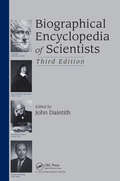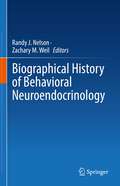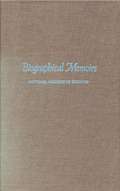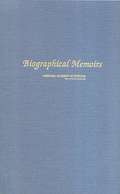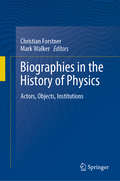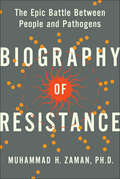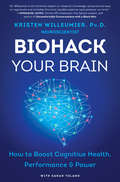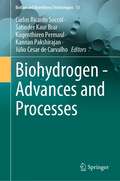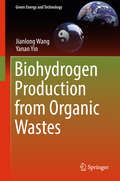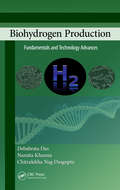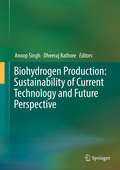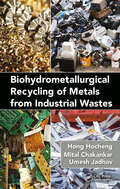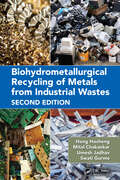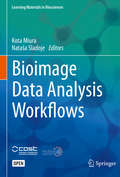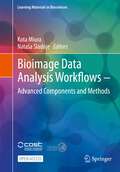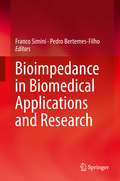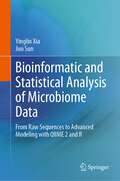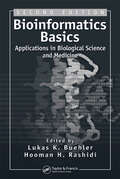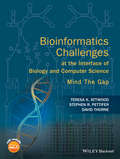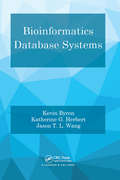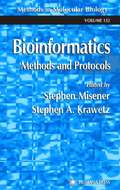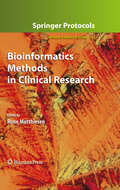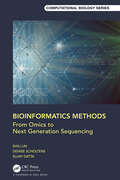- Table View
- List View
Biographical Encyclopedia of Scientists
by John DaintithNew Edition of a Highly Regarded Reference As the first fully updated version in almost a decade, this comprehensive compendium brings together 2400 scientists who have made important contributions to the wide world of science. Rather than a Who's-Who style laundry list, this user-friendly resource provides essential biographical information and fo
Biographical History of Behavioral Neuroendocrinology
by Randy J. Nelson Zachary M. WeilBehavioral neuroendocrinologists are interested in the interactions between hormones and behaviors. This unique book tracks the development of behavioral neuroendocrinology from the first recognized paper in the field by Arnold Berthold in 1849 to the major contributors of the past century. It traces the history and development of the field by exploring the women and men who conducted the studies that revealed these hormone-behavioral relationships. Most chapters are written by the individuals who knew these pioneers best, and describe their stories and discuss the ways in which their work has shaped the field. Now is the perfect time for this book. The field is burgeoning and interest in the development of theoretical perspectives is thriving. Moreover, although this field was dominated by men early on, it has become a field with near sexual parity among its faculty, society membership, and leadership, and thus serves as an example of equitable science, training, and advocacy.
Biographical Memoirs: Volume 74
by National Academy of Sciences StaffMemoirs of histories more distinguished figures
Biographical Memoirs: Volume 91
by National Academy of Science the National AcademiesBiographical Memoirs is a series of essays containing the life histories and selected bibliographies of deceased members of the National Academy of Sciences. The series provides a record of the life and work of some of the most distinguished leaders in the sciences, as witnessed and interpreted by their colleagues and peers. They form a biographical history of science in America--an important part of our nation's contribution to the intellectual heritage of the world.
Biographies in the History of Physics: Actors, Objects, Institutions
by Mark Walker Christian ForstnerThis book sheds new light on the biographical approach in the history of physics by including the biographies of scientific objects, institutions, and concepts. What is a biography? Can biographies also be written for non-human subjects like scientific instruments, institutions or concepts? The respective chapters of this book discuss these controversial questions using examples from the history of physics. By approaching biography as metaphor, it transcends the boundaries between various perspectives on the history of physics, and enriches our grasp of the past.
Biography of Resistance: The Epic Battle Between People and Pathogens
by Muhammad H. ZamanAward-winning Boston University educator and researcher Muhammad H. Zaman provides a chilling look at the rise of antibiotic-resistant superbugs, explaining how we got here and what we must do to address this growing global health crisis.In September 2016, a woman in Nevada became the first known case in the U.S. of a person who died of an infection resistant to every antibiotic available. Her death is the worst nightmare of infectious disease doctors and public health professionals. While bacteria live within us and are essential for our health, some strains can kill us. As bacteria continue to mutate, becoming increasingly resistant to known antibiotics, we are likely to face a public health crisis of unimaginable proportions. “It will be like the great plague of the middle ages, the influenza pandemic of 1918, the AIDS crisis of the 1990s, and the Ebola epidemic of 2014 all combined into a single threat,” Muhammad H. Zaman warns.The Biography of Resistance is Zaman’s riveting and timely look at why and how microbes are becoming superbugs. It is a story of science and evolution that looks to history, culture, attitudes and our own individual choices and collective human behavior. Following the trail of resistant bacteria from previously uncontacted tribes in the Amazon to the isolated islands in the Arctic, from the urban slums of Karachi to the wilderness of the Australian outback, Zaman examines the myriad factors contributing to this unfolding health crisis—including war, greed, natural disasters, and germophobia—to the culprits driving it: pharmaceutical companies, farmers, industrialists, doctors, governments, and ordinary people, all whose choices are pushing us closer to catastrophe.Joining the ranks of acclaimed works like Microbe Hunters, The Emperor of All Maladies, and Spillover, A Biography of Resistance is a riveting and chilling tale from a natural storyteller on the front lines, and a clarion call to address the biggest public health threat of our time.
Biohack Your Brain: How to Boost Cognitive Health, Performance & Power
by Kristen WilleumierA neuroscientist’s groundbreaking, science-driven plan for revitalizing, nourishing and rejuvenating your most essential asset—your brain.Your brain is the most essential organ in your body. The brain and spinal cord are intimately connected to every bodily system and organ, so when it is balanced everything in your body and mind will function more efficiently. It’s vitally important to take proactive steps now, or you risk losing everything, including your ability to think clearly, be creative, remember details, solve problems and retain your memory.In Biohack Your Brain, leading neuroscientist Dr. Kristen Willeumier reveals how you can change your brain by making simple and easy modifications to your lifestyle. Combining clinical experience with revolutionary science, she details how biohacking your brain can boost your cognitive performance and so much more.Dr. Willeumier’s essential guidebook shows you the most effective techniques to prevent memory loss and neurodegenerative disorders like Alzheimer’s disease—and even how to overcome negative thoughts and stress. Through research and case studies, you’ll learn how to upgrade your nutritional choices along with the effective use of supplements, brain games, and physical activity to overcome cognitive damage, whether it’s from previous injuries, such as a concussion or a bad fall or from the effects of living in modern day times.Dr. Willeumier shares her own story alongside those from the NFL players and other clients she has worked with to help you leverage the latest research to find personal solutions. Biohack Your Brain teaches you how to take better care of your brain, and also how to enhance your memory, lose excess weight, increase your energy and vitality in order to create the best health and life possible.
Biohybrid Systems: Nerves, Interfaces and Machines
by Ranu JungThe discipline of neurodesign is a highly interdisciplinary one, while at the same time in the process of maturing towards real-life applications. The breakthrough about to be achieved is to close the loop in communication between neural systems and electronic and mechatronic systems and actually let the nervous system adapt to the feedback from the man-made systems. To master this loop, scientists need a sound understanding of neurology, from the cellular to the systems scale, of man-made systems and how to connect the two. These scientists comprise medical scientists, neurologists and physiologists, engineers, as well as biophysicists. And they need the topics in a coherently written work with chapters building upon another.
Biohydrogen - Advances and Processes (Biofuel and Biorefinery Technologies #13)
by Satinder Kaur Brar Carlos Ricardo Soccol Kugenthiren Permaul Kannan Pakshirajan Júlio Cesar de CarvalhoThis book presents an introduction to biohydrogen production and the recent advances and developments of the cleanest biofuel produced from bioresources. Biohydrogen has the highest energy content relative to weight and burns cleanly – generating just water. It is the best choice for fuel cells, where it generates electricity directly, in its reaction with oxygen. Biohydrogen occurs naturally as part of digestive gases from mammals and can be produced in specially designed anaerobic biodigesters, or through photocatalysis with microalgae. The gas is also easy to purify and use. The economic production of biohydrogen is still full of challenges: From the efficient and rapid conversion of the substrate to storage, transportation, and safe use, there are several aspects that need to be developed. Research in this field is addressing the issue of efficient large-scale production from several directions: Substrate pretreatment to enhance digestibility, metabolic networks analysis, microbial diversity and succession to highlight constraints in production, bioreactor, and downstream design to improve throughput and reduce costs, to name a few. The ideas and technologies presented in this book contribute to achieving the UN Sustainable Development Goal 7: Affordable and Clean Energy. The book is written for researchers and students interested in biorefinery and biofuel technologies.
Biohydrogen Production from Organic Wastes (Green Energy and Technology)
by Jianlong Wang Yanan YinThis book comprehensively introduces fundamentals and applications of fermentative hydrogen production from organic wastes, consisting of eight chapters, covering the microbiology, biochemistry and enzymology of hydrogen production, the enrichment of hydrogen-producing microorganisms, the pretreatment of various organic wastes for hydrogen production, the influence of different physicochemical factors on hydrogen production, the kinetic models and simulation of biological process of fermentative hydrogen production, the optimization of biological hydrogen production process and the fermentative hydrogen production from sewage sludge. The book summarizes the most recent advances that have been made in this field and discusses bottlenecks of further development. This book gives a holistic picture of this technology and details the knowledge through illustrative diagrams, flow charts, and comprehensive tables. It is intended for undergraduate and graduate students who are interested in bioenergy and wastes management, researchers exploring microbial fermentation process, and engineers working on system optimization or other bioenergy applications.
Biohydrogen Production: Fundamentals and Technology Advances
by Debabrata Das Namita Khanna Chitralekha Nag DasguptaThis book compiles the fundamentals of biohydrogen production technology. It offers comprehensive coverage of microbiology, biochemistry, feedstock requirements, and molecular biology of the biological hydrogen production processes. It also gives insight into scale-up problems and limitations. In addition, the book discusses mathematical modeling of the processes involved in biohydrogen production and the software required to model the processes. It also summarizes research advances, discusses bottlenecks of the various processes, and covers the process economy, policy, and environmental impact of this technology.
Biohydrogen Production: Sustainability of Current Technology and Future Perspective
by Anoop Singh Dheeraj RathoreIncrease in green, renewable and sustainable energy demand due to higher environmental impacts (e. g. Greenhouse gases emissions, climate change, etc. ) on consumption of fossil fuel resource put down an extra pressure on government, researchers and industrialists. Among several available biofuel options, biohydrogen is considered as one of the best environmentally clean fuel and a strong candidate to fulfil the future demand of sustainable energy resource. Although, biohydrogen production technology and its use as a fuel is still in infancy stage. Selection of most sustainable production pathway, increase in production upto industrial scale and cost efficiency are some issue still persist with the biohydrogen research. "Biohydrogen Production: Sustainability of Current Technology and Future Perspective" is giving an insight for the sustainable production of biohydrogen at industrial scale. The process of biohydrogen production is complex and to opt the best suited production system for industrial scale is a frantic task. This book will provide an in depth information on all available technologies for biohydrogen production and feedstock options to choose upon. This book is also providing information on present status of the research in the field and possibility to change future fuel economy in to biohydrogen economy. Experts views provided in the chapters by renowned researchers from all over the globe in the field of biohydrogen research made this book a cornucopia of present research and future perspective of biohydrogen. This book is targeted at the researchers working on biohydrogen as well as the bioenergy scientist planning to move towards biohydrogen research. This book will provide a platform for motivation of researchers and industrialists for innovative ideas and thoughts to bring biohydrogen production at industrial scale.
Biohydrometallurgical Recycling of Metals from Industrial Wastes
by Hong Hocheng Mital Chakankar Umesh JadhavAlthough many available metal recycling methods are simple and fast, they are also expensive and cause environmental pollution. Biohydrometallurgical processing of metals offers an alternative to overcome these issues, as the use of biological means not only helps to conserve dwindling ore resources but also fulfills the need for the unambiguous need to extract metals in nonpolluting, low-energy, and low-cost way. This book covers biohydrometallurgy and its application in the recovery of metals from secondary sources like wastes. It aims to provide readers with a comprehensive overview of different wastes for metal recovery and biological treatment methods that are both environmentally friendly and economically viable.
Biohydrometallurgical Recycling of Metals from Industrial Wastes
by Hong Hocheng Mital Chakankar Umesh Jadhav Swati GurmeAlthough many available metal recycling methods are simple and fast, they are also expensive and cause environmental pollution. Biohydrometallurgical processing of metals offers an alternative to overcome these issues, as the use of biological means not only helps to conserve dwindling ore resources but also fulfills the unambiguous need to extract metals in nonpolluting, low-energy, and low-cost way. This book covers biohydrometallurgy and its application in the recovery of metals from secondary sources like wastes. Fully updated for a new edition, it provides readers with a comprehensive overview of different wastes for metal recovery and biological treatment methods that are both environmentally friendly and economically viable. Offers a detailed explanation about generation of different metals containing industrial waste Explains traditional and new biological methods of recycling Reflects research advances across different industrial waste sources including electric vehicle batteries and LCDs from computers and other devices Focuses on each waste type and explores in detail the biohydrometallurgical recovery of metals from that waste Discusses fundamental microbial studies in bioleaching and updates about the use of emerging technologies and integrated techniques with different methods in combination for metal recovery Features a new chapter on techniques for metal extraction from bioleachate This book serves as an essential resource for researchers and professional engineers working in chemical and environmental engineering and biotechnology.
Bioimage Data Analysis Workflows (Learning Materials in Biosciences)
by Kota Miura Nataša SladojeThis Open Access textbook provides students and researchers in the life sciences with essential practical information on how to quantitatively analyze data images. It refrains from focusing on theory, and instead uses practical examples and step-by step protocols to familiarize readers with the most commonly used image processing and analysis platforms such as ImageJ, MatLab and Python. Besides gaining knowhow on algorithm usage, readers will learn how to create an analysis pipeline by scripting language; these skills are important in order to document reproducible image analysis workflows. The textbook is chiefly intended for advanced undergraduates in the life sciences and biomedicine without a theoretical background in data analysis, as well as for postdocs, staff scientists and faculty members who need to perform regular quantitative analyses of microscopy images.
Bioimage Data Analysis Workflows ‒ Advanced Components and Methods (Learning Materials in Biosciences)
by Kota Miura Nataša SladojeThis open access textbook aims at providing detailed explanations on how to design and construct image analysis workflows to successfully conduct bioimage analysis. Addressing the main challenges in image data analysis, where acquisition by powerful imaging devices results in very large amounts of collected image data, the book discusses techniques relying on batch and GPU programming, as well as on powerful deep learning-based algorithms. In addition, downstream data processing techniques are introduced, such as Python libraries for data organization, plotting, and visualizations. Finally, by studying the way individual unique ideas are implemented in the workflows, readers are carefully guided through how the parameters driving biological systems are revealed by analyzing image data. These studies include segmentation of plant tissue epidermis, analysis of the spatial pattern of the eye development in fruit flies, and the analysis of collective cell migration dynamics. The presented content extends the Bioimage Data Analysis Workflows textbook (Miura, Sladoje, 2020), published in this same series, with new contributions and advanced material, while preserving the well-appreciated pedagogical approach adopted and promoted during the training schools for bioimage analysis organized within NEUBIAS – the Network of European Bioimage Analysts. This textbook is intended for advanced students in various fields of the life sciences and biomedicine, as well as staff scientists and faculty members who conduct regular quantitative analyses of microscopy images.
Bioimpedance in Biomedical Applications and Research
by Franco Simini Pedro Bertemes-FilhoThis book is based on the best contributions to the advancement of bioimpedance knowledge and use from the Latin American Congress series, CLABIO. Basic bioimpedance facts as well as promising and original contributions to bioimpedance theory and applications are presented, giving the reader stimulating material for reflection, decision making, and further experiments. Contributions come from a diverse international pool of experts and address topics on electrode and skin impedance modelling, tomography, spectroscopy, instrumentation, and clinical applications.
Bioinformatic and Statistical Analysis of Microbiome Data: From Raw Sequences to Advanced Modeling with QIIME 2 and R
by Jun Sun Yinglin XiaThis unique book addresses the bioinformatic and statistical modelling and also the analysis of microbiome data using cutting-edge QIIME 2 and R software. It covers core analysis topics in both bioinformatics and statistics, which provides a complete workflow for microbiome data analysis: from raw sequencing reads to community analysis and statistical hypothesis testing. It includes real-world data from the authors’ research and from the public domain, and discusses the implementation of QIIME 2 and R for data analysis step-by-step. The data as well as QIIME 2 and R computer programs are publicly available, allowing readers to replicate the model development and data analysis presented in each chapter so that these new methods can be readily applied in their own research. Bioinformatic and Statistical Analysis of Microbiome Data is an ideal book for advanced graduate students and researchers in the clinical, biomedical, agricultural, and environmental fields, as well as those studying bioinformatics, statistics, and big data analysis.
Bioinformatics Basics: Applications in Biological Science and Medicine
by Lukas K. Buehler Hooman H. RashidiEvery researcher in genomics and proteomics now has access to public domain databases containing literally billions of data entries. However, without the right analytical tools, and an understanding of the biological significance of the data, cataloging and interpreting the molecular evolutionary processes buried in those databases is difficult, if
Bioinformatics Challenges at the Interface of Biology and Computer Science: Mind the Gap
by David Thorne Teresa K. Attwood Stephen R. PettiferThis innovative book provides a completely fresh exploration of bioinformatics, investigating its complex interrelationship with biology and computer science. It approaches bioinformatics from a unique perspective, highlighting interdisciplinary gaps that often trap the unwary. The book considers how the need for biological databases drove the evolution of bioinformatics; it reviews bioinformatics basics (including database formats, data-types and current analysis methods), and examines key topics in computer science (including data-structures, identifiers and algorithms), reflecting on their use and abuse in bioinformatics. Bringing these disciplines together, this book is an essential read for those who wish to better understand the challenges for bioinformatics at the interface of biology and computer science, and how to bridge the gaps. It will be an invaluable resource for advanced undergraduate and postgraduate students, and for lecturers, researchers and professionals with an interest in this fascinating, fast-moving discipline and the knotty problems that surround it.
Bioinformatics Database Systems
by Jason T. Wang Kevin Byron Katherine G. HerbertModern biological databases comprise not only data, but also sophisticated query facilities and bioinformatics data analysis tools. This book provides an exploration through the world of Bioinformatics Database Systems. The book summarizes the popular and innovative bioinformatics repositories currently available, including popular primary genetic and protein sequence databases, phylogenetic databases, structure and pathway databases, microarray databases and boutique databases. It also explores the data quality and information integration issues currently involved with managing bioinformatics databases, including data quality issues that have been observed, and efforts in the data cleaning field. Biological data integration issues are also covered in-depth, and the book demonstrates how data integration can create new repositories to address the needs of the biological communities. It also presents typical data integration architectures employed in current bioinformatics databases. The latter part of the book covers biological data mining and biological data processing approaches using cloud-based technologies. General data mining approaches are discussed, as well as specific data mining methodologies that have been successfully deployed in biological data mining applications. Two biological data mining case studies are also included to illustrate how data, query, and analysis methods are integrated into user-friendly systems. Aimed at researchers and developers of bioinformatics database systems, the book is also useful as a supplementary textbook for a one-semester upper-level undergraduate course, or an introductory graduate bioinformatics course.
Bioinformatics For Dummies
by Cedric Notredame Jean-Michel ClaverieWere you always curious about biology but were afraid to sit through long hours of dense reading? Did you like the subject when you were in high school but had other plans after you graduated? Now you can explore the human genome and analyze DNA without ever leaving your desktop!Bioinformatics For Dummies is packed with valuable information that introduces you to this exciting new discipline. This easy-to-follow guide leads you step by step through every bioinformatics task that can be done over the Internet. Forget long equations, computer-geek gibberish, and installing bulky programs that slow down your computer. You'll be amazed at all the things you can accomplish just by logging on and following these trusty directions. You get the tools you need to:Analyze all types of sequencesUse all types of databasesWork with DNA and protein sequencesConduct similarity searchesBuild a multiple sequence alignmentEdit and publish alignmentsVisualize protein 3-D structuresConstruct phylogenetic treesThis up-to-date second edition includes newly created and popular databases and Internet programs as well as multiple new genomes. It provides tips for using servers and places to seek resources to find out about what's going on in the bioinformatics world. Bioinformatics For Dummies will show you how to get the most out of your PC and the right Web tools so you'll be searching databases and analyzing sequences like a pro!
Bioinformatics Methods and Protocols (Methods in Molecular Biology #132)
by Stephen A. Krawetz Stephen MisenerHands-on users and experts survey the key biological software packages, offering useful tips and an overview of current developments. Among the sequence analysis systems reviewed are GCG, Omiga, MacVector, DNASTAR, PepToolTM, GeneToolTM, and the Staden Package. Molecular biology software includes Genotator and sequence-similarity searching using FASTA, CLUSTAL multiple sequence alignment, and phylogenetic analysis. Web-based resources are examined for primary sequence databases, primary sequence analysis methods, and clinical databases useful in molecular medicine. Numerous illustrative examples to teach the reader how to solve problems are included. Bioinformatics: Methods and Protocols constitutes a gold-standard reference for today's scientists who wish to develop and hone their bioinformatics skills towards the discovery of new biological relationships.
Bioinformatics Methods in Clinical Research (Methods in Molecular Biology #593)
by Rune MatthiesenIntegrated bioinformatics solutions have become increasingly valuable in past years, as technological advances have allowed researchers to consider the potential of omics for clinical diagnosis, prognosis, and therapeutic purposes, and as the costs of such techniques have begun to lessen. In Bioinformatics Methods in Clinical Research, experts examine the latest developments impacting clinical omics, and describe in great detail the algorithms that are currently used in publicly available software tools. Chapters discuss statistics, algorithms, automated methods of data retrieval, and experimental consideration in genomics, transcriptomics, proteomics, and metabolomics. Composed in the highly successful Methods in Molecular BiologyTM series format, each chapter contains a brief introduction, provides practical examples illustrating methods, results, and conclusions from data mining strategies wherever possible, and includes a Notes section which shares tips on troubleshooting and avoiding known pitfalls. Informative and ground-breaking, Bioinformatics Methods in Clinical Research establishes a much-needed bridge between theory and practice, making it an indispensable resource for bioinformatics researchers.
Bioinformatics Methods: From Omics to Next Generation Sequencing (Chapman & Hall/CRC Computational Biology Series)
by Sujay Datta Shili Lin Denise ScholtensThe past three decades have witnessed an explosion of what is now referred to as high-dimensional `omics' data. Bioinformatics Methods: From Omics to Next Generation Sequencing describes the statistical methods and analytic frameworks that are best equipped to interpret these complex data and how they apply to health-related research. Covering the technologies that generate data, subtleties of various data types, and statistical underpinnings of methods, this book identifies a suite of potential analytic tools, and highlights commonalities among statistical methods that have been developed. An ideal reference for biostatisticians and data analysts that work in collaboration with scientists and clinical investigators looking to ensure rigorous application of available methodologies. Key Features: Survey of a variety of omics data types and their unique features Summary of statistical underpinnings for widely used omics data analysis methods Description of software resources for performing omics data analyses
